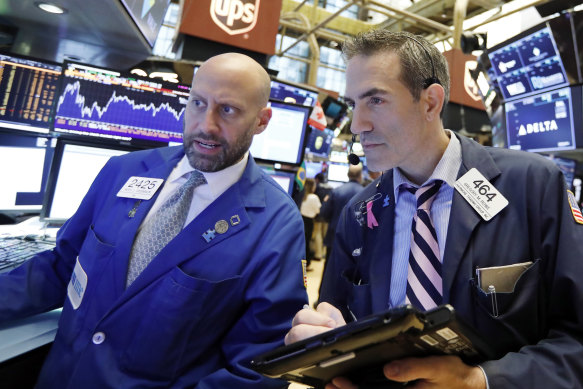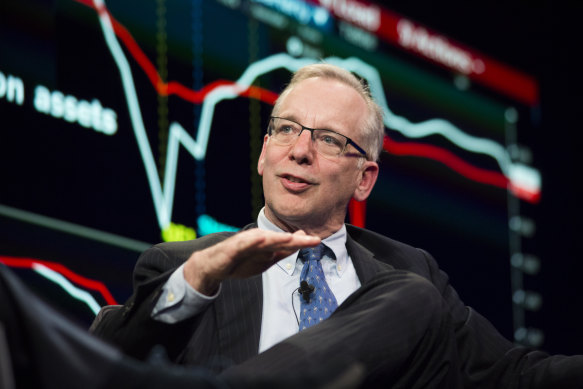
While the headline rate of inflation has been dropping steadily and was down to 2.5 per cent in August, services inflation remains sticky and “core” inflation, excluding food and energy prices, actually edged up slightly last month.
Beneath the headline CPI number, there are signs of disinflation in goods, food and energy prices but are being offset by services inflation, driven by “shelter costs” that, because they are based on imputed rents for America’s entire housing stocks rather than recent leasing transactions, tend to lag what’s actually happening in the economy by up to 18 months.

Markets are on edge about what the Fed will do. Credit: AP
Also, while the Fed strips out volatile food and energy costs from its preferred core inflation data, oil prices have tumbled from more than $US81 a barrel late last month to around $US71 a barrel. That fall, mirrored within America’s domestic oil market, where West Texas Intermediate crude is now trading below $US70 a barrel, will feed into lower business input costs and, hence, into the core inflation rate.
The jobs market has remained quite strong with an unemployment rate of 4.1 per cent, but has been weakening.
The Fed has, like many central banks, a dual mandate. It has to balance the risks to both inflation and employment.
Loading
With the inflation rate tracking down steadily and signs that economic activity is slowing, it would seem that the risks to jobs and economic growth are greater than the risk of reigniting inflation.
Former Federal Reserve Bank of New York president Bill Dudley cited the asymmetrical risks in arguing that the Fed had scope to cut its policy rate, the federal funds rate, by 50 basis points, or half a percentage point.
“I think there’s a strong case for 50,” he said.
“I know what I’d be pushing for.”
Financial markets are pricing in only a 25 basis point cut but have also pencilled in 100 basis points of cuts by the end of the year, which would imply at least one 50 basis point reduction at the remaining two meetings and up to 250 basis points by the end of next year.
If the Fed shared that view – and we’ll get a better sense of what the members of the Open Market Committee think when the famous “dot plot” data containing the projections of the individual members is released after the meeting – it would be legitimate to question why they wouldn’t start the rate-cutting process with a 50 point bang.
At the moment, the market pricing suggests that either option – 25 basis points or 50 basis points – is an even-money chance, although the odds on a 50 basis point cut strengthened late last week.
Dudley made the point that this is unusual.
“It’s very unusual to go into the meeting with this level of uncertainty. Usually, the Fed doesn’t like to surprise markets,” he said.
Indeed, in recent years, the Fed has tried hard to ensure markets aren’t surprised by its decisions.
A 25 basis point reduction in the federal funds rate would suggest that the Fed policymakers are unsure of the balance of risks within the economy, which would hardly be confidence-inspiring and would leave open the possibility that, as occurred when the Fed was too slow to raise rates as inflation gained momentum, they do too little, too late.

Former Federal Reserve Bank of New York president Bill Dudley is arguing for a 50 basis point cut. Credit: Bloomberg
It is, of course, possible that there is a 25 basis point cut this week but that the dot plot and the Fed’s chair, Jerome Powell, amplify its impact with their dovish projections and his dovish commentary and make it clear that there will be a succession of rate cuts well into next year.
The number of rate cuts the Fed expects and where it projects the federal funds rate to be by the end of 2025 might turn out to be more influential for markets and the economy than the individual sizes of the cuts. The Fed, if it wants to be conservative, could avoid over-committing itself this week while using its jaw-boning to amplify the effects of a 25 basis point reduction.
In recent years, the Fed has tried hard to ensure markets aren’t surprised by its decisions.
US bond yields have already pre-empted the Fed decision, with the yields on two-year Treasuries falling from above 4 per cent a month ago to 3.58 per cent and 10-year bond yields from 3.91 per cent to 3.65 per cent. There is confidence that there will be a rate cut priced in, even if its size remains a question mark.
Complicating the decision-making (although Powell and the Fed would never admit it) is the US election and the big-spending, deficit and debt-expanding policies of the protagonists.
The grab bag of policies Kamala Harris has promised would have far less impact on inflation than the radical trade and immigration policies Donald Trump has said he will pursue, but both suites of policies would add something – in Trump’s case a lot – to the inflation rate and could force the Fed into an early reversal of the course it might otherwise follow over the next year or so.
That might provide another motivation, albeit an unstated one, for a central bank that wants and needs to be seen as apolitical to be cautious in the early phase of the rate-reduction cycle.
Loading
For various reasons, therefore, it will be a fine-line decision as to whether the Fed goes with a cautious 25 basis points move or the more impactful 50 basis points cut.
The Business Briefing newsletter delivers major stories, exclusive coverage and expert opinion. Sign up to get it every weekday morning.









 Add Category
Add Category